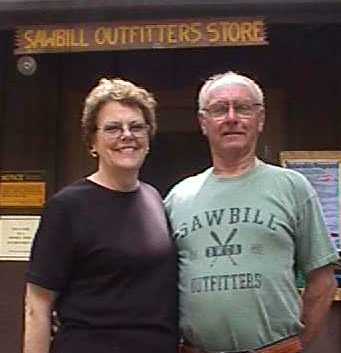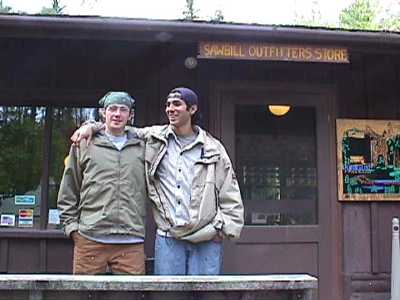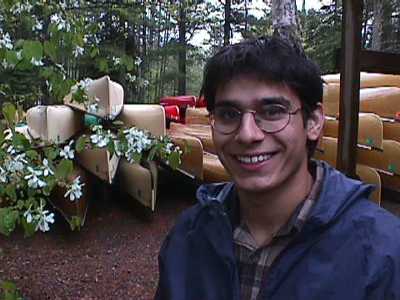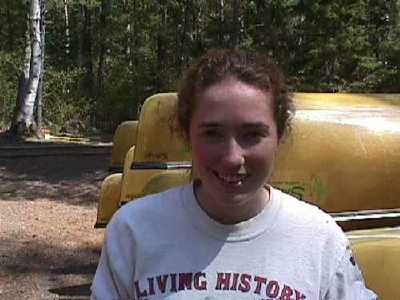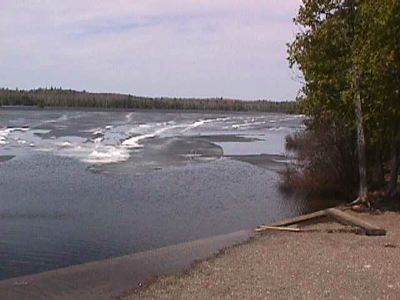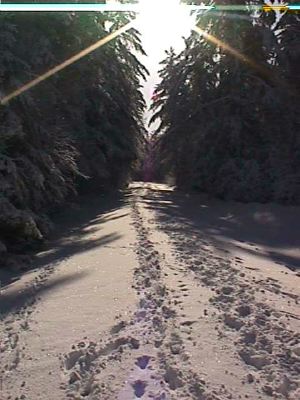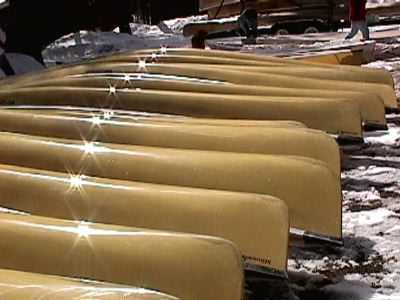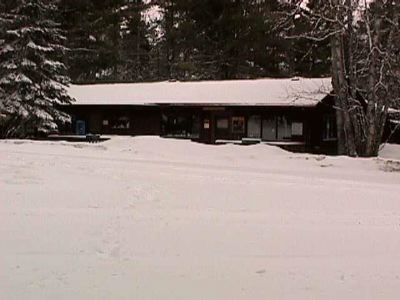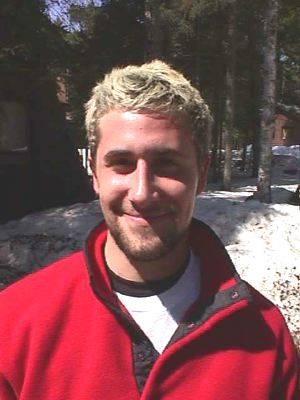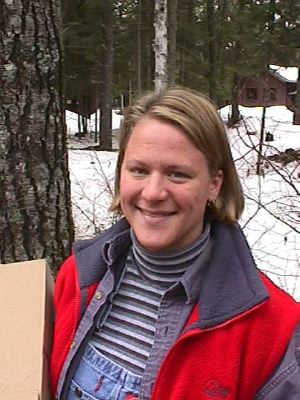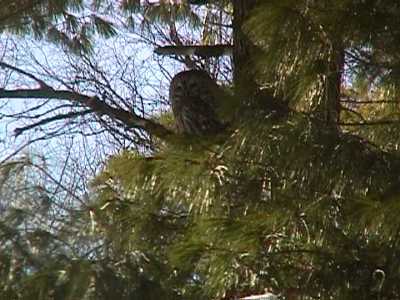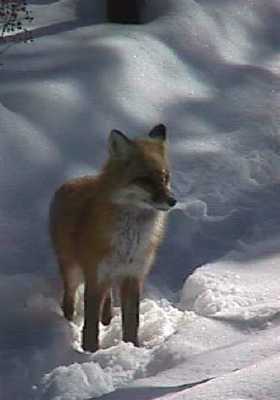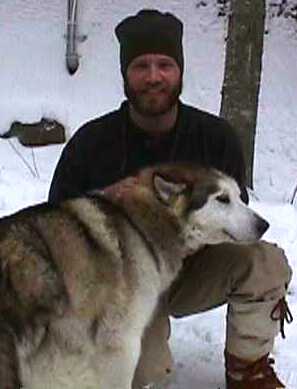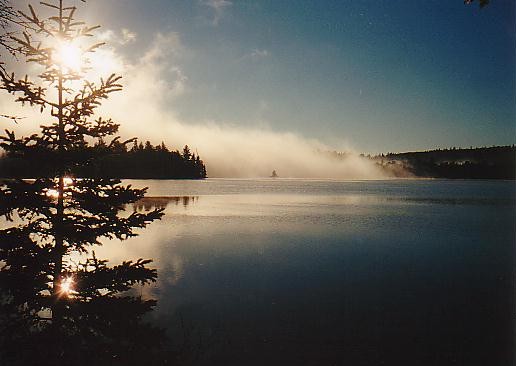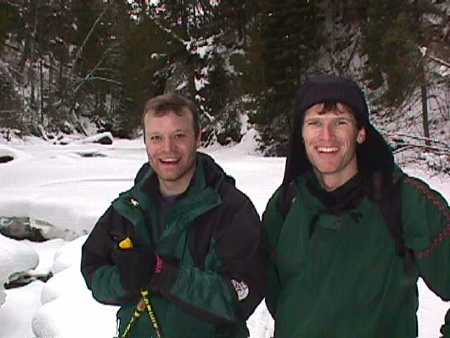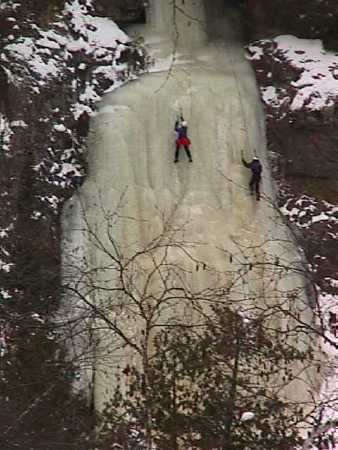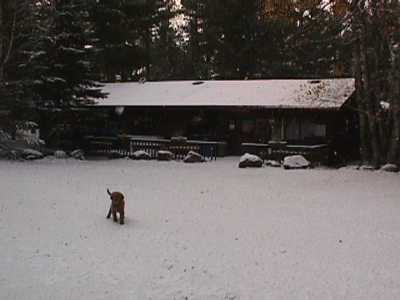9/30/00 – Ed Dallas, the Poet Laureate of Sawbill, writes:
IT WON’T BE LONG NOW
At this time of year,
those who paddle
out from the Sawbill
find each night’s campfire
a bit warmer,
sleeping bag zipped
all the way up,
stronger morning coffee
and portage trail mud
mimics potter’s clay.
Oh, some will enjoy crispness
of blue sky dotted
with winter-chased geese
and yellow aspen-leaf rain
while others
(garageless city dwellers)
see only hardships
brought on by dreaded
WINTER PARKING RULES
and City Officials eager
to call SNOW EMERGENCIES.
9/29/00 – We had a visit on Wednesday from Wilson and Jane
Arbogast. In 1934, Wilson and Jane, along with their father George,
stepmother Jean, and two other brothers, built Sawbill Lodge on
the south end of Sawbill Lake. Theirs is an amazing depression
era story. They built a beautiful log lodge and twelve cabins
from trees cut right on Sawbill Lake. It was a true northwoods
pioneer effort under very difficult conditions. Wilson had many
pictures from those times and I was impressed with how happy everyone
looked. It was a hard life, but a great life. Sawbill Lodge went
out of business in 1980. The Arbogast kids left the lodge to join
the military during WWII. Their father and Jean divorced and Jean
ran the lodge until she sold it in 1960. Jean started us in business
in 1957 when she spun off the outfitting business to my parents,
Frank and Mary Alice Hansen. – Bill
9/28/00 – Annie Pearson (nee’ Stritmatter), former Sawbill
crew member, now lives in Nicaragua. She sent up this picture
of a 47′ aluminum boat that her husband, Marcos, made. It is the
second of three that he is making for an organization called Alistar.
It will be used on Rio Coco for hauling freight and people to
remote towns. Annie asks if we would like a few for BWCA Wilderness
use. They only weigh two tons.
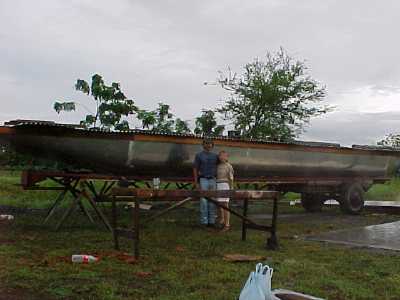
Pictured below are Brad (Gus) Gustason and friends who biked
from Duluth to Sawbill and back last weekend. It took them four
days total. They had wet and cold weather, but were revived by
the Summit beer selection in the Sawbill store and the sauna.
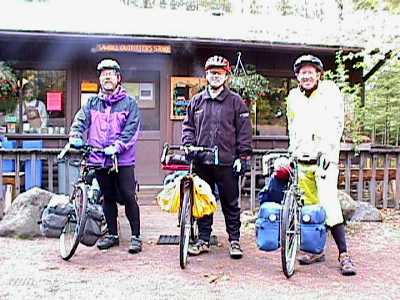
Homer the puppy is thriving. Gus and Sunny have taught him
well, as you can see…

9/23/00 – Gus and Sunny, Sawbill’s most popular residents,
would like to announce the arrival of their new friend, Homer
Howard Hansen to Sawbill.
 Homer, age 8 weeks.
Homer, age 8 weeks.
Sawbill customer Eric Flom sent along this picture from the
fires in Montana this summer. Impressive.
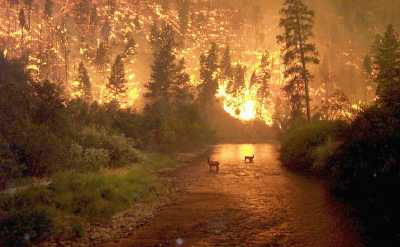 Photographed by John McColgan, Bureau of Land Management,
Photographed by John McColgan, Bureau of Land Management,
Alaska Fire Service
9/17/00 – Yesterday morning, Dave and Harriet, who live in
a camping trailer here at Sawbill, woke up at 6:30 a. m. to some
strange noises outside their door. Peering out the window, they
discovered two canadian geese standing in the driveway honking
at each other. I’m aware that geese are common, especially in
urban areas, but we rarely see them here except flying overhead
in "v" formation.
9/14/00 – Picture taken by Dave Freeman in front of the Sawbill
Store. The pine martens are casing the place…
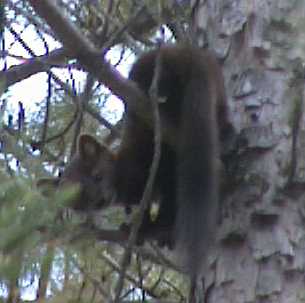
9/13/00 – A variety of news here at Sawbill. Moose continue
to be sighted at a record pace. I saw three in one trip to town
a few days ago. All were bulls who were starting into their annual
mating period known as "rutting." These gentleman were
obviously preoccupied and unwilling to concede possession of the
road without a stare down. One huge bull even took a few threatening
steps in my direction. I was stopped a respectful distance away,
but still shifted quickly in reverse – just in case.
Ruthie Hansen departed yesterday, bound for her freshman year
at the University of Chicago. People have expressed amazement
that a country girl like Ruthie would choose one of the most urban
campuses in the country. But, she is looking forward to the excitement
and cultural enrichment that Chicago can offer. Perhaps we can
entice her to submit a few impressions of Chicago from a northwoods
point of view for this newsletter… if she has time.
Sawbill crew member Erik Hoekstra had an unfortunate accident
with our big 3/4 ton pickup truck yesterday. He was driving down
the Grade Road with the recycling trailer in tow and got sucked
into some soft gravel. After a few fishtails, he ended up in the
ditch. It was unlucky that the embankment was deep and steep at
this point and the truck ended up on its side. Erik was thankfully
unhurt. The truck is now in Richie Nelson’s body shop having most
of its sheet metal unwrinkled.
The fall colors have started in earnest along the Sawbill Trail.
The maple hillsides near Tofte are showing about 20% red. Farther
up, the underbrush is fully aflame with color. The birches and
aspen are showing sudden splashes of yellow which are beautiful
set against the vivid green background.
9/4/00 – David and Kathryn Olson, from New Jersey, have traveled
many miles in canoe country over the years. They took the pictures
below on their trip a couple of weeks ago and have many more on
their website.
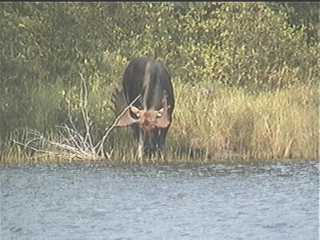

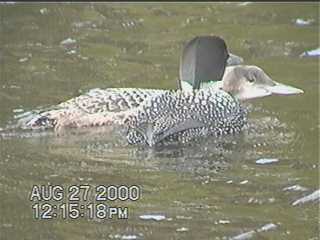
9/3/00 – We received this story by email this morning:
A LIVELY PORTAGE — POLLY TO KAWASACHONG, BWCA, 2000
By Brand Frentz
We were forewarned to stay alert on the double portage from
Kawasachong through Townline to Lake Polly in the South Central
BWCA. In mid-July outfitter Bill Hansen’s Sawbill Newsletter (www.sawbill.com)
told about a smart, aggressive, and apparently pretty hungry bear
who had been marauding along that trail. The bruin reportedly
sneaked up on people, then when their backs were turned darted
out and grabbed the food and ran! That put me on edge, but in
fact we saw no bears in a week (probably because a good hazelnut
crop had ripened). As it turned out, the wildlife was not as wild
as their human counterparts. What we did see was some portage
action, portaging, some original styles and interesting problems.
It was on the return trip. We had worked hard to get from Little
Sag to Koma in one day, and started the last day late, and sore.
As we moved slowly homeward the 190-rod portage from Townline
to Kawasachong loomed as the back breaker.
As luck would have it, we faced a brisk south wind, right in
our faces — just as it had been out of the north and right in
our faces when we came in. Because we were worn down to start
with, it did not surprise me that as we crossed Lake Polly a pair
of athletic young guys in an old 17-foot Alumacraft easily overtook
us. We exchanged a few words, and they told us their impressive
route: put-in at Hog Creek and in six days they had gone all the
way west to Gabbro Lake and then back up the Kawishiwi River.
To me that is a long trip, and they looked stronger than ever.
We wished them good speed, although they already had it, and paddled
on behind.
By the time we reached the portage they were loaded, each with
a big pack on his back and a small one in front. What they did
next did surprise me. They bent over and picked up the boat together,
flipped it up over their heads and set it down with the seats
resting on their big packs. This portage starts with a mean little
rocky climb. They bounded up it like mountain goats, and out of
our sight for good. So that is one way to carry the canoe, and
it obviously was working for them.
We got loaded, Vycki with the food pack and incidentals, me
with the canoe (Penobscot 16) and my day pack. Before going far
we met a woman, then a man, then another, all with light loads
and reserved (if not sullen) attitudes. One of them warned us
that there were "terrible mudholes" on the second portage.
Then I came to the next curiosity of this portage, two women
struggling with a red Penobscot 17. It was on the ground as I
came up, and I couldn’t help noticing that it had no yoke. Instead
it had two broken pieces of wood connected to the gunnels, and
nothing between them. They told me that one of the guys had been
carrying it on the previous portage, and the yoke "just broke."
Very unfortunate, I agreed, so what are you doing now? They
were on a day trip from Kawasachong to Lake Polly to fish, and
they were determined to push on. How? They had secured PFDs to
the bow and stern seats, then bent their heads forward and put
the boat there, resting on their necks. Now that is a hard way
to portage! I had to admire their grit, and wished them good luck.
More with portaging than fishing.
After we completed the portage normally, me making a second
round for the two other packs (equipment and clothing), we paddled
across Townline to meet the day’s main challenge. We had now been
warned that it was muddy in addition to being long. We loaded
and crossed over. Things seemed okay. Along the way we passed
two young couples, who said a friendly "Hello," and
gave a fleeting impression of uncertainty. At the put-in I rested
a minute admiring our old friend Kawasachong, then started back
for the final pull — two 40-pound packs, front and back, and
me already dragging. I thought to myself, "I’ll at least
enjoy the walk over, with nothing to carry."
You bet! I hadn’t gone 100 yards when I came up to one of the
young guys, struggling with a huge red seabag, a 17-foot Mad River
Explorer on the ground next to him. Although I could see the problem,
I said, "Hi, what’s up?" He muttered something about
this portaging being a tricky business. "Here," I said
with my best BWCA manners, "Let me have that bag. The canoe
is plenty by itself." He looked astonished. He muttered a
breathless, "Awesome!" as I took his pack and he took
the canoe.
As we walked I told him that it was normal for me to help him
out, and that the other day on this very portage a guy had done
the same for me. He told me that this was their first time in
the BWCA and he didn’t know how he could carry the pack and the
canoe at once (this was the first real portage of their trip).
Before long we overtook his wife, who was cheerfully carrying
two more big seabags, front and back. He beamed to her, "Look
what this awesome guy is doing. He’s taking our pack." Well,
they were from Chicago, where I guess "awesome" is a
popular word, and helping out strangers may not be as common on
the street there as on portage trails in the BWCA. We chatted
about the beauty of the woods as we approached the muddy section.
Now I had been through this mud already. It was okay. I just
sloshed through in sandals, right down the middle where the trail
once was. My friends from Chicago had not seen it. In fact they
had only been in the BWCA for a couple of hours. Suddenly just
ahead I heard, "Yiiiy!" and saw the woman sinking, right
down to the packs! I dashed up and grabbed one arm, and another
guy who happened to be coming the other way came over quickly
and held her up on the other side.
Then slowly, carefully, we lifted her and her two big packs
out of the rippling mudhole. When she was back at ground level,
we set her down in the middle of the trail, where the mud was
3-4 inches deep but solid underneath. She gasped for air. Her
husband with the Explorer on his shoulders came up just then,
and she excitedly told him what had happened. More "awesomes,"
and everyone was happy.
The reason she went in, she said, was that she didn’t like
the looks of the mud on the trail. So she stepped off to the side,
where it appeared to be grassy but was not.
We crossed the rest of the trail together in fine spirits.
At the end, the Townline Lake put-in, I politely suggested that
they consider double portaging next time, and they agreed enthusiastically.
They thanked me, of course, and I said, "No problem, anybody
would’ve done it." As I grabbed my two packs and headed across
the portage for the last time I heard her say to her husband,
voice crackling with emotion, "Wow, that was exhilarating!"
I was so anxious to tell Vycki about my adventures that I completely
forgot that this was supposed to be the big challenge of the day,
and the portage was over in a flash. Time flies when you’re having
fun. (The fatigue hit later, as it always does.)
9/2/00 – A man just walked into the store with a 27.9 lb Northern
Pike tied to a paddle. He told us he caught the huge fish on a
little spoon and 6 lb test line. Unfortunately our digital camera
is having some technical difficulties, so we weren’t able to get
a picture of the fish. We’re storing it in our freezer for the
rest of the weekend. I was afraid to tell him that the last time
someone stored a huge fish in our freezer, Adam pulled it out
and threatened to use the stiff fish to play a few rounds of wiffle-ball.
Labor Day Weekend is in full-swing here at Sawbill. The campground
was full last night, and is full tonight too. There’s been a steady
stream of people in the store and dome all day long. I know the
summer’s coming to an end when I overhear kids in the store discussing
their school schedules. Oh my.
Sincerely Yours, -Ruthie
9/1/00 – 108 Carleton college freshman arrived at Sawbill today.
In the morning they will split into 12 separate groups and venture
into the wilderness on 12 different routes. Former crew members
Natasha "BA" Warner and Annie Strupeck are here to help
out over the busy weekend. It’s great to see some different faces
sitting behind the counter in the store. I’d like to write more,
but Hey! There’s work to be done!
Signing off, -Ruthie
